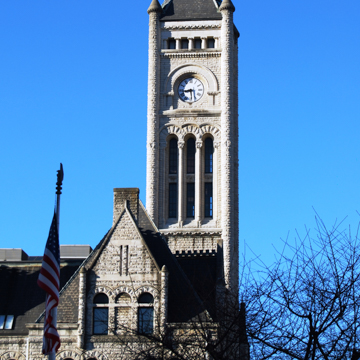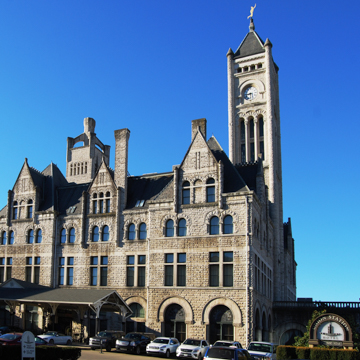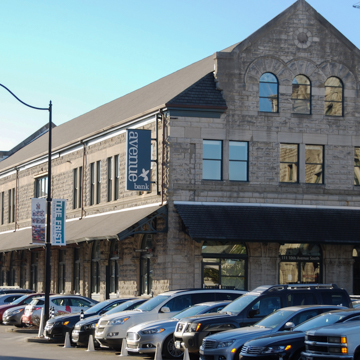You are here
Union Station Hotel
Begun in 1898 and completed in 1900, Union Station in Nashville stands as a symbol of the cooperative efforts of the Louisville and Nashville (L&N) Railroad and the Nashville, Chattanooga and St. Louis Railway (NC&StL). As the main terminus in Nashville during the peak of rail transportation, Union Station is an important part of the city’s transportation history. As a Romanesque Revival monument, Union Station was an architectural landmark from the moment it was completed. In addition to the main station, which contained several floors of office space, an attached train shed and a separate baggage building were part of the original design.
The building was located on a major thoroughfare just outside the Nashville’s commercial areas, providing convenient access for travelers to and from the city. Richard Monfort, chief engineer for the L&N, designed the three-and-one-half-story Romanesque Revival building, using Tennessee limestone for the foundation and Bowling Green gray ashlar limestone for the exterior walls. The large semicircular arches and clock tower capped by a statue of Mercury are noteworthy design features on the building. Above the lobby is a sixty-five-foot-high, vaulted, stained glass ceiling.
The Tennessee State Legislature granted a charter to the Nashville and Chattanooga Railroad Company in 1845 for a rail line from Nashville to Chattanooga. The line opened in 1854, acquired the Nashville and Northwestern Railroad in 1872, and became the NC&StL the same year. In subsequent decades, the company expanded by leasing or buying other lines, making Nashville a major rail hub. In 1898 the State Legislature passed a “Depot Bill” that allowed the railway firm, then called the Louisville and Nashville Terminal Company, to acquire additional city property and build a new railroad station. The resulting Union Station manifests the power and stature of the railroad in Nashville at the turn of the twentieth century.
By the middle of the century, passenger train travel to Nashville had tapered off and freight travel was moved to Radnor Yards in Nashville in 1955. L&N and NC&StL merged in 1957, with L&N in control. The rail line’s offices were moved to Louisville, Kentucky, that year and Union Station stood nearly empty. In 1975, when Amtrak took over the baggage building, passenger travel ceased and the station was closed. Plans to use the building for federal offices did not materialize, but in December 1986 Union Station reopened as a hotel, which continues to operate under different ownership. The baggage shed has been converted into use as a restaurant. In early 2001, the train shed was demolished.
References
Brumbaugh, Thomas. “The Architecture of Nashville’s Union Station.” In Tennessee Historical Quarterly27, no. 1 (Spring 1968): 3-12.
“National Historic Landmark De-Designation Report: Nashville Union Train Station.” August 2002. On file at the Tennessee Historical Commission.
Building Conservation Technology. “Historic Structure Report: Union Station, Nashville, Tennessee.” November 1980.
Historic American Buildings Survey. “Union Station.” http://www.loc.gov/pictures/collection/hh/item/tn0039/.
Zembala, Dennis M., “Nashville Union Station,” Davidson County, Tennessee. National Register of Historic Places Nomination Form, 1969. U.S. Department of the Interior, Washington, DC.
Writing Credits
If SAH Archipedia has been useful to you, please consider supporting it.
SAH Archipedia tells the story of the United States through its buildings, landscapes, and cities. This freely available resource empowers the public with authoritative knowledge that deepens their understanding and appreciation of the built environment. But the Society of Architectural Historians, which created SAH Archipedia with University of Virginia Press, needs your support to maintain the high-caliber research, writing, photography, cartography, editing, design, and programming that make SAH Archipedia a trusted online resource available to all who value the history of place, heritage tourism, and learning.






